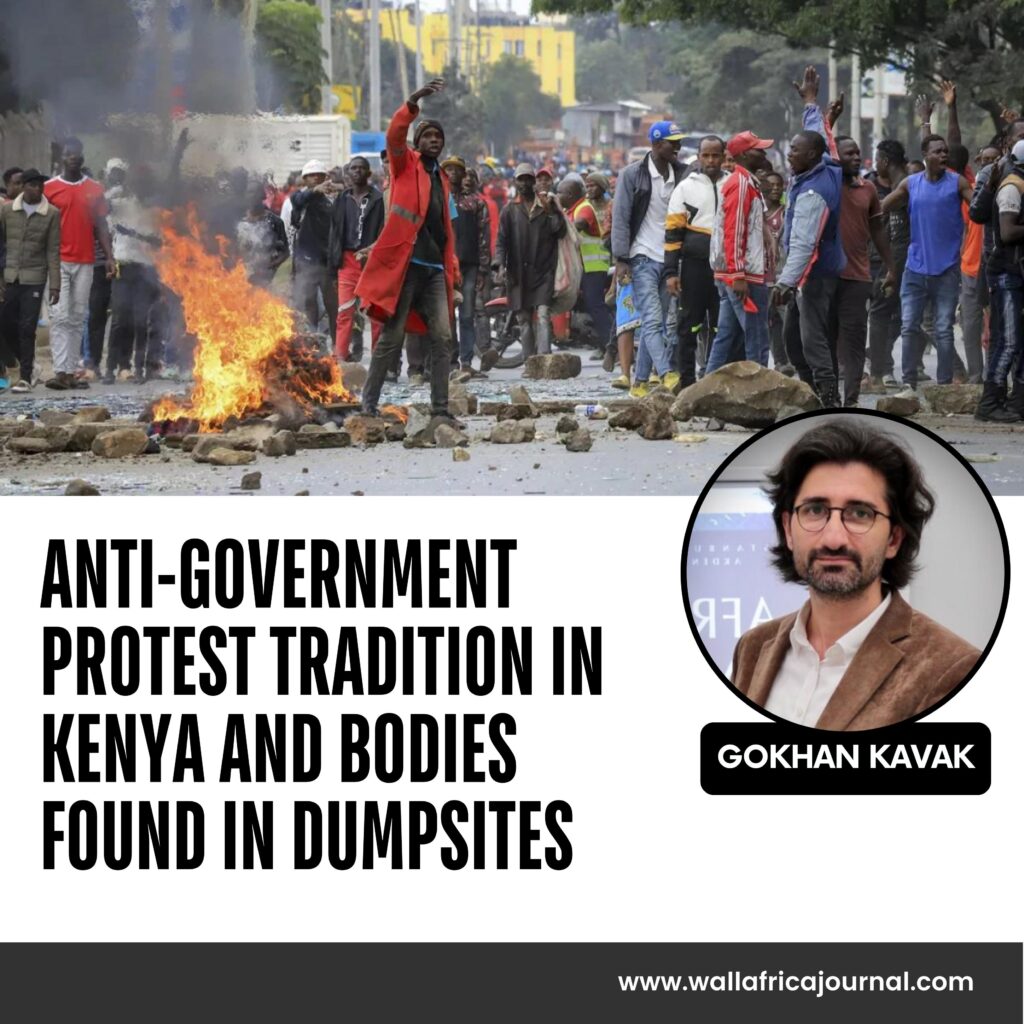While the global agenda is focused on the assassination in the United States or the NATO summit, Kenya, one of Africa’s prominent countries politically and economically, has been rocked by anti-government protests over the past few weeks.
In fact, what has brought recent protests in Kenya, an African country with a tradition of demonstrations, into the spotlight is the occurrence of deaths during these protests and the discovery of bodies in dumpsites days after the events.
Indeed, following the disproportionate intervention of security forces during days-long protests across different regions of the country in June, approximately 40 protesters initially lost their lives. After these anti-government protest, Kenyan President William Ruto made the expected move by first sending the controversial tax bill back to parliament and dissolving the cabinet. Kenya Police Chief Japhet Koome, who became the target of public anger due to the deaths during the protests, was also removed from his position.
Just as the situation seemed to calm down with all these developments, a new headline emerged: Bodies found in dumpsites during the days when many people were reported missing in the anti-government protests!
If we look back at the recent past, we can see that the Kenyan people have a deep-rooted tradition of protesting. From demonstrations against femicides to rallies in support of Palestine, Kenyans express their reactions to both domestic and international developments by taking to the streets. Indeed, the photos captured, the slogans chanted, and the coordination among the protesters during the recent demonstrations clearly reflect this tradition.
On the other hand, Kenya, besides being an outward-looking country, hosts many foreign media organizations and is one of the few African countries where non-African journalists can follow protests on the streets. Despite this image recorded both domestically and internationally, Kenya witnesses’ events as bloody as those in a closed-off country.
The current situation has raised questions about Kenya once again, despite it being an African country that sent a “peace mission” to Haiti and signed an agreement with the EU on July 1st to increase mutual trade and investment. This comes in light of the disproportionate intervention against protesters and the discovery of bodies in dumpsites.
- The majority living in the suburbs, the elite minority
The main cause of the ongoing protests in Kenya, which have led to numerous deaths over several days, is the “2024 Finance Bill” proposing tax adjustments and imposing tariffs on various essential goods, coupled with the country’s turbulent economic situation. Additionally, the discontent among the predominantly young population is evident. According to 2024 data from Afrobarometer, a public opinion research organization in Africa, 46% of the youth consider the health sector to be the country’s biggest problem, 39% cite the rising cost of living, 30% highlight unemployment, and 25% point to corruption as the most significant issues.[1]
In fact, Kenya’s Ministry of Finance was aiming to close a deficit of about 1.56 billion dollars in the 2024-2025 budget through tax adjustments. The bill proposes a 16% increase in flour and a 25% percent increase in oil, which are among the basic foodstuffs. The bill, which also envisages an increase in basic cleaning products, is expected to negatively affect millions of people, especially women and children. With the hike decision, which will also negatively affect vehicle owners, it is planned to levy an annual tax of 2.5 percent of the vehicle value. On the other hand, the bill aims to raise the environmental tax and technological materials such as cell phones and cameras. Within the scope of the bill, which is expected to have a negative impact on the health system, an additional tax will be imposed on hospitals with more than 50 beds, while the tax rate on imported products is proposed to be increased from 2.5 percent to 3 percent.
All these developments led to demonstrations in the country. The protesters, mostly young people, coordinated on especially social media and started demonstrations against the government’s tax hike on June 18. However, the development that brought the demonstrations to the international media was the killing of about 40 demonstrators on June 27, when security forces opened fire on the demonstrators after the demonstrators attempted to enter the parliament.

Opposition demonstrations are not new in Kenya… The coalition led by opposition leader Raila Odinga, who declared that he did not recognize the elected government after losing the presidential election in 2022, organized demonstrations in 2023, citing the cost of living. According to Kenya National Commission for Human Rights (KNCHR), the three-day protests held on July 23-25 resulted in bloodshed and 10 people lost their lives. It was noteworthy that most of the people who lost their lives in these demonstrations were killed by gunshots and the injuries were mostly caused by police bullets.
Even bloodier than this was the 2007 election process. The opposition, led by Odinga, the leader of the Orange Democracy Movement, did not accept the election results and in the process that developed after the disproportionate use of force by the police, nearly a thousand people died and more than 250 thousand people had to leave their homes.
– Bodies found in a garbage dump after demonstrations
After the demonstrations in Kenya, many people were reported missing. There was no news about the missing people, but a few days later, the bodies of at least 10 people were found in a garbage dump in the capital Nairobi, causing attention to turn to Kenya again.[2]
The government launched an investigation into the bodies, but Kenyans were angry. So much so that they blocked the entry of the investigation committee that came to investigate the scene.
The Independent Policing Oversight Authority (IPOA) claimed that the bodies found showed signs of torture.[3] The crime scene was less than 100 meters from a police station, raising questions about police involvement. Indeed, the Criminal Investigation Department, which is leading the investigation, said without elaborating that it showed that all the victims were killed in the same way. “Serial killer” arrested after bodies found in Kenya dump. Police say Collins Jomaisi Khalusha, 33, confessed to having killed 42 women since 2022, including his own wife.
– A difficult test for Ruto’s government
Socio-economic developments are at the heart of Kenya’s unrest. Despite progress in education, health and social security, Kenya ranks 146rd out of 192 countries in the human development index.[4] While Kenya is a livable country with its natural resources and climatic conditions, it is important to take into account the colonial legacy, tribal voting habits, political coalitions and the vortex of political corruption when analyzing political developments.
On the socio-economic side, we should not forget the inequality of land and income distribution, corruption and economic inequality that has persisted in Kenya for decades. Most importantly, we must not forget the income inequality between the majority poor people in the suburbs and the minority rich elite in the “liberated areas”.
In Kenya, the rising star of East Africa in the fields of trade, banking, IT and media, where literacy rates approach 90 percent, young people closely follow global developments. However, as in 2007, the country’s anti-government protests continues.
The opposition demonstrations that started after the 2022 elections in Kenya turned into criticism of economic policies last year. After bloody demonstrations in recent weeks, the bill was withdrawn, parliament was dissolved and the police chief was dismissed. However, the harsh intervention of security forces against protesters in Kenya has not ended!
While about 10 people were killed in last year’s demonstrations, nearly 40 people were killed in the demonstrations a few weeks ago. This also shows that the tradition of demonstrations in the country is in danger. However, the bodies found in the garbage dump days after the demonstrations (regardless of the cause of death) will be a black mark on the demonstrations in the near future and a black mark on Kenyan history in the long run.
It will also be a difficult challenge for the Ruto government, in power since 2022.
[1] https://x.com/afrobarometer/status/1812138261537525900
[2] https://khrc.or.ke/press-release/discovery-of-dismembered-bodies-in-kware-dumpsite-nairobi/
[3] https://www.rfi.fr/en/africa/20240713-kenya-watchdog-probes-possible-police-link-to-bodies-dumped-in-nairobi-landfill-mukuru
[4] https://hdr.undp.org/data-center/country-insights#/ranks

